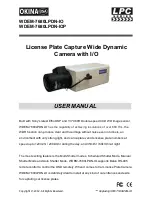
ANGLE OF VIEW AND FOCAL LENGTH
minimizing the telescoping distance
and the fluctuation of aberration at
different shooting distances. This
system is particularly effective for
macro lenses (which encompass a wide
range of shooting distances) and wide-
angle lenses (for Single-Lens Reflex
cameras) whose lens composition is
asymmetric. SIGMA uses the floating
system for the MACRO 50 mm f/2.8 EX
DG lens and the large-aperture wide-
angle 28 mm f/1.8 EX DG ASPHERICAL
MACRO lenses.
•DF (Dual Focus) System
The DF (Dual Focus) system disengages the linkage between the internal
focusing mechanism and outer focusing ring when the focusing ring is
moved to the AF position. This system provides easy and precise handling
of the lens, since the focusing ring does not rotate during autofocusing. The
wide focusing ring also enables easy and accurate manual focusing.
•OS (Optical Stabilizer) Function
The OS function uses two sensors inside the lens to detect vertical and
horizontal movement of the camera and works by moving an optical image
stabilizing lens group to effectively compensate for camera shake. The OS
function offers the equivalent of using a shutter speed 4 stops faster making
it suitable for telephoto and low light
photography.
As the stabilizing feature is built into
the lens, it can be designed
specifically to suit the characteristics
of that lens. This provides precise
compensation for camera shake
throughout the entire zoom range.
This also enables the correctly
stabilized image to appear in the
viewfinder aiding autofocus and
composition.
PRINCIPLES OF THE LENS
•Angle of View
The focal length determines the area in which objects can be reproduced on
the image sensor surface. The angle of view is the area that the lens can
photograph and is expressed in degrees. The angle of view indicated in the
brochure is the angle relative to the diagonal line of 36 mm x 24 mm and
20.7 mm x 13.8 mm frames. As the focal length becomes larger, the field
angle becomes smaller and the image larger.
•f Value (f-Number; f-Stop)
The aperture settings of a lens are called f-numbers or f-stops. An f-number
represents a ratio between lens focal length and the effective diameter of a given
aperture. Because it is related to focal length, the f-number is also called the
relative aperture. The f-number equals the focal length of the lens divided by the
entrance pupil of the aperture. Aperture settings are marked so that each position
changes the amount of light passing through the lens by a factor of 2: the light is
either doubled, or reduced by one-half. That is, a high number represents a
smaller aperture, one that stops twice as much light as the previous aperture.
Conversely, a lower number represents a larger aperture, one that increases light
twice as much as the pervious number. The speed of a lens is the f-number
of its maximum effective diameter — i.e., when the aperture is wide open.
•Depth of Field
When you focus on an object, a certain area in
front of and behind the object is also in focus;
depth of field refers to the size of this area that is
in focus. The depth of field or the range of focus
becomes larger when you stop down (decrease
the size of the aperture), or smaller when you
open up (increase the size of the aperture). The
depth of field is smaller at smaller shooting
distances even when the aperture size remains
unchanged, and is larger at larger shooting
distances. The depth of field is also dependent
on the focal length of the lens; it is larger for
lenses of smaller focal lengths or wider angles,
and smaller for lenses of larger focal lengths or
telephoto lenses, if aperture and the distance
camera to subject remain the same.
•Perspective
Depending on the focal length of the lens, the background appears close to or
further away from the object. This visual effect is called perspective. With a
wide-angle lens the background will appear remote, and the distance from the
subject to the background will be emphasized; when the focal length of a
telephoto lens is large, the background will appear to be closer to the object. To
take advantage of this effect, use a wide-angle lens to capture both the
background and the object, and a telephoto lens to emphasize only the object.
•
Floating System
28 mm F1.8 EX DG ASPHERICAL MACRO
•
Floating System
MACRO 50 mm F2.8 EX DG
Camera shake correction mechanism OFF
Camera shake correction mechanism ON
F2.8
F22
LENS TECHNOLOGY
•Aspherical Lens
This lens provides high optical performance while maintaining a compact
size. For example, the 12-24 mm f/4.5-5.6 EX DG ASPHERICAL lens widens
the range of wide-angle lenses, and it provides distortion-free images with
image reproduction performance equivalent to that of a single-focal length
lens. Aspherical lenses allow the production of high-quality images from
compact, lightweight telephoto zoom lenses.
APO (APO Lens)
SIGMA’s APO zoom lenses minimize
color aberration. As the refractive
index of glass depends on the
wavelength of light, color aberration
occurs when different colors form
images at different points. This
problem often occurs with telephoto
lenses, but the Special Low-Dispersion
(SLD) glass and Extraordinary Low
Dispersion (ELD) used in SIGMA’s
APO lenses helps to compensate for
color aberration, thereby allowing
them to produce of sharp images.
•APO MACRO
Although telephoto zoom lenses
can be used closer to the object
than fixed focal length telephoto
lenses, there is still a minimum
shooting distance. SIGMA has
made this minimum distance smaller and developed the zoom MACRO lens
for taking close-up photographs of the same quality as those taken with a
regular MACRO lens, while maintaining the performance specific to an
APO lens. Rather than carrying around the cumbersome accessories
required for close-up work, the photographer can now take photographs at
a magnification of 1:2 (one half
lifesize) using a telephoto lens, by
quickly shifting from the normal
setting to the full macro setting.
•Inner and Rear Focus
Conventional focusing has normally
been performed by moving either all lens groups as a fixed unit or only
the first lens group. AF cameras are now widely used, even for close-up
photography. Consequently, demand has arisen for a focusing system that
will keep the length of the lens unchanged while showing little fluctuation
of aberration. In response to this demand, SIGMA has developed a new
inner focus system that moves two lens groups inside the telephoto and
telephoto MACRO lenses. This system has floating elements that
substantially improve the close-up
capability of the lens. The super
wide angle lens having a large front-
lens uses a rear focusing system to
move the rear-lens apparatus and
enhance the floating effect, and the
18-200mm F3.5-6.3 DC features an
inner focusing system to move the
secondary lens group during
focusing. This lens has a minimum
focusing distance of 45 cm / 17.7
inch throughout entire zoom range.
The rear focus system ensures high-
speed focusing with the wide lens
20mm F1.8 EX DG ASPHERICAL
RF.
•Floating System
The floating system is used to control
the focus. This system moves the
different lens groups in the optical
system to different positions, thereby
•
Inner Focus
APO 70- 200mm F2.8 II EX DG MACRO HSM
•
Inner Focus
18-200mm F3.5-6.3 DC
•
Rear Focus
20mm F1.8 EX DG ASPHERICAL RF
•
APO MACRO
APO 70 - 300 mm F4 - 5.6 DG MACRO
The more you know about lenses, the greater will be your enjoyment of photography.
The basics of lenses and lens technology--which play a key role in the creative process--are explained herein.
Special Low Dispersion (SLD)
Lens Element
Ordinary
Glass Element
Amount of Secondary
Spectrum
Amount of Secondary
Spectrum
Comparison of
Chromatic Aberration Correction
LENS KNOWLEDGE
84.1° · 24mm
18.2° · 135mm
75.4° · 28mm
12.3° · 200mm
FISHEYE
180° · 15mm
46.8° · 50mm
8.2° · 300mm
122° · 12mm
34.3° · 70mm
5° · 500mm
103.7° · 17mm
23.3° · 105mm
3.1° · 800mm
FISHEYE
180° · 8mm
94.5° · 20mm
Summary of Contents for 10-20mm F4-5.6 EX DC / HSM
Page 1: ......

































